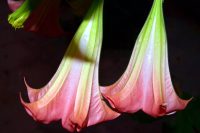Atropine is a tropane alkaloid that naturally occurs in plants of the nightshade family (Solanaceae). Members of this family include deadly nightshade (Atropa belladonna), henbane (Hyoscyamus niger), Angel’s trumpet (Brugmansia spp.) and Jimson weed (Datura stramonium). Atropine acts as an anticholinergic agent, blocking the action of the neurotransmitter acetylcholine in the central and peripheral nervous system.
Why do some plants produce atropine?
Atropine is a secondary metabolite, which is an organic compound produced by a plant that is not directly involved in its growth, development, or reproduction, but often serves a role as a defence against pests and herbivory. The presence of secondary metabolites makes the plants less palatable or even toxic to animals, thus deterring feeding and increasing the plant’s chances of survival.
The biosynthesis of atropine in plants occurs in pericycle and endodermis cells located inside the outer layer of the roots. From there they are transported to other parts of the plant. It takes a number of enzymatic steps to synthesise atropine which are outlined below:
- Putrescine (CH₂)₄(NH₂)₂ is a pungent compound (the same compound responsible for the foul odour of decomposition) formed by the decarboxylation of common amino acids L-ornithine or L-arginine that is catalysed by ornithine or arginine decarboxylase.
- Putrescine is methylated by the enzyme putrescine N-methyltransferase (PMT) to form N-methylputrescine. The enzyme N-methylputrescine oxidase (MPO) oxidises N-Methylputrescine into 4-methylaminobutanal.
- 4-Methylaminobutanal undergoes a series of transformations and rearrangements involving the addition of a C2 unit from acetyl-CoA, eventually leading to the formation of tropinone which is then reduced to form tropine.
- In the last step, tropine combines with phenyllactic acid (PLA), to form littorine which involves several enzymatic steps. Littorine is then converted into hyoscyamine, which is then racemised into atropine.
Mechanism of action
Atropine is a muscarinic receptor antagonist (MRA) which binds to muscarinic receptors in the glands (where they control secretion), heart, eyes, smooth muscles of the gastrointestinal tract, and central and peripheral nervous system. Ingestion of atropine can induce anticholinergic toxic syndrome with a host of clinical signs.
Muscarinic receptors are a type of receptor found on nerve cells that respond to acetylcholine. There are several types of muscarinic receptors (M¹ through M⁵), and they play various roles in the nervous system. Atropine blocks the ability of acetylcholine (ACh) to activate the muscarinic receptors. Acetylcholine plays key roles in muscle contraction, heart rate regulation, glandular secretion, cognitive function, digestion and the autonomic nervous system.
Clinical signs
Atropine toxicosis affects multiple organ systems within the body, clinical signs depend on the dose.
- Heart: Atropine increases the heart rate by blocking the muscarinic receptors that would normally help slow down the heart rate.
- Lungs: In the lungs, atropine reduces bronchial muscle tone and mucus secretions. This can result in bronchodilation. In high enough doses, the anticholinergic effects of atropine can cause the lung secretions to thicken and dry out, which makes them difficult to clear.
- Eyes: Causes dilation of the pupils (mydriasis), sensitivity to light (photophobia) and impairs the ability to focus on near objects (cycloplegia) by blocking the muscarine receptors in the ciliary body and the sphincter pupillae.
- Bladder: Inhibits contraction of the urinary bladder, potentially causing urinary retention.
- Nervous system: Atropine is able to cross the blood-brain barrier and affect the central nervous system, which can cause restlessness, slurred speech, confusion, delirium and hallucinations. Extreme doses can cause respiratory depression or the slowing or stopping of automatic breathing.
- Glandular secretion: Acetylcholine stimulates secreting glands, when this action is blocked by atropine, their function is inhibited. Symptoms include dry eyes and mouth, reduced perspiration, decreased secretions of the bronchial glands and a slow down of digestion in the GI tract, resulting in constipation.
How dangerous is atropine?
The level of toxicity depends on the level of atropine in the plant, which can vary from species to species as well as which parts of the plant were consumed. Seeds and berries have the highest concentration. There is no known lethal adult dose, however, in children, ten milligrams can be fatal.
Levels of atropine can vary from plant to plant. Deadly nightshade (Atropa belladonna) is one of the most toxic plants in the Eastern Hemisphere. All parts of the plant are poisonous, the dark purple, shiny berries contain the highest concentrations of atropine. Even touching deadly nightshade can cause skin irritation in some people, and it is important to wear protective clothing when removing deadly nightshade from your garden.
Treatment
There is no antidote to atropine ingestion. The goal of treatment is to further absorption and manage clinical signs.
- Decontamination: Medications to induce vomiting if ingestion was recent. This will be followed by activated charcoal. Activated charcoal absorbs toxins through adsorption. In this case, atropine binds to the surface of activated charcoal, which acts like a sponge, and allows the toxin to be safely eliminated through the digestive system.
- Fluid therapy: Intravenous fluids to treat or prevent dehydration. Fluids can also help the body flush out any toxins in the system.
- Breathing support: Supplemental oxygen or mechanical ventilation for patients who are experiencing difficulty breathing.
- Benzodiazepines: Benzodiazepines are drugs that act as central nervous system depressants. They increase the activity of GABA, a neurotransmitter that inhibits brain activity. Benzodiazepines help manage the neurological and psychiatric symptoms associated with atropine toxicity. It reduces agitation, controls seizures, and manages anxiety or panic.
Medicinal uses
As Swiss physician and chemist Paracelsus said in 1538, ‘All things are poison and nothing is without poison; only the dose makes a thing, not a poison.’ This saying is shortened to ‘the dose makes the poison.‘ This means even some deadly toxins such as botulinum, produced by Clostridium botulinum, are safe at low doses. While non-toxic substances such as water can be toxic in high doses.
Atropine is one such example of this. In the medical field, atropine has a wide range of use due to its anticholinergic properties. Common brand names include AtroPen, Atreza, Sal-Tropine, Isopto Atropine, Atropine-Care, Atropisol, Ocu-Tropine, Atrosulf-1.
Medical uses
- Preoperative medication: Atropine is used before surgery to reduce saliva, mucus and other secretions, which is important to prevent complications during procedures, especially those which involve the respiratory tract.
- Bradycardia (abnormally slow heart rate): Atropine blocks the action of the vagus nerve on the heart, which increases the heart rate.
- Overactive bladder: Atropine relaxes the muscles in the bladder, this reduces urinary frequency and urgency.
- Eye procedures and diseases: Atropine drops are used to dilate the pupils, which helps optometrists and ophthalmologists examine the inside of the eye. As a powerful cycloplegic, atropine paralyses the ciliary muscle of the eye. The ciliary muscle is responsible for changing the shape of the lens, which can cause pain in people with a corneal ulcer. Atropine is also used to treat uveitis. By dilating the pupil, it prevents the formation of synechiae, which are adhesions that can develop between the iris and the lens.
- Resuscitation: In emergency medicine, atropine helps to manage asystole or pulseless electrical activity.
- Organophosphate toxicosis: Atropine is used as an antidote for organophosphate and nerve agent poisons. It blocks muscarinic receptors to counteract the effects of excessive acetylcholine.
- Secretions: Due to its ability to inhibit glandular secretions, atropine can help people with excessive sweating (hyperhidrosis). People close to death are unable to clear secretions from the throat, and develop the ‘death rattle’. Atropine can relieve this by reducing the production of secretions.
Conclusion
Atropine is a tropane alkaloid that naturally occurs in plants of the nightshade family (Solanaceae).
Common members include: Deadly Nightshade (Atropa belladonna), Jimsonweed (Datura stramonium), Henbane (Hyoscyamus niger), Thornapple (Datura innoxia), Scopolia (Scopolia carniolica), Bittersweet (Solanum dulcamara), Mandrake (Mandragora officinarum), Sacred Datura (Datura wrightii), Belladonna Lily (Amaryllis belladonna), Angel’s Trumpet (Brugmansia species).
Atropine is an anticholinergic agent. It blocks the action of the neurotransmitter acetylcholine in the central and peripheral nervous system.
Despite the toxicity of atropine, it has a number of critical uses in the medical field.
Julia is a writer and landscape consultant from Wollongong with a love of horticulture. She had been an avid gardener for over 30 years, collects rare variegated plants and is a home orchardist. Julia is passionate about learning and sharing her knowledge of plant propagation and plant toxicology. Whether it’s giving advice on landscape projects or sharing tips on growing, Julia enjoys helping people make their gardens flourish.




